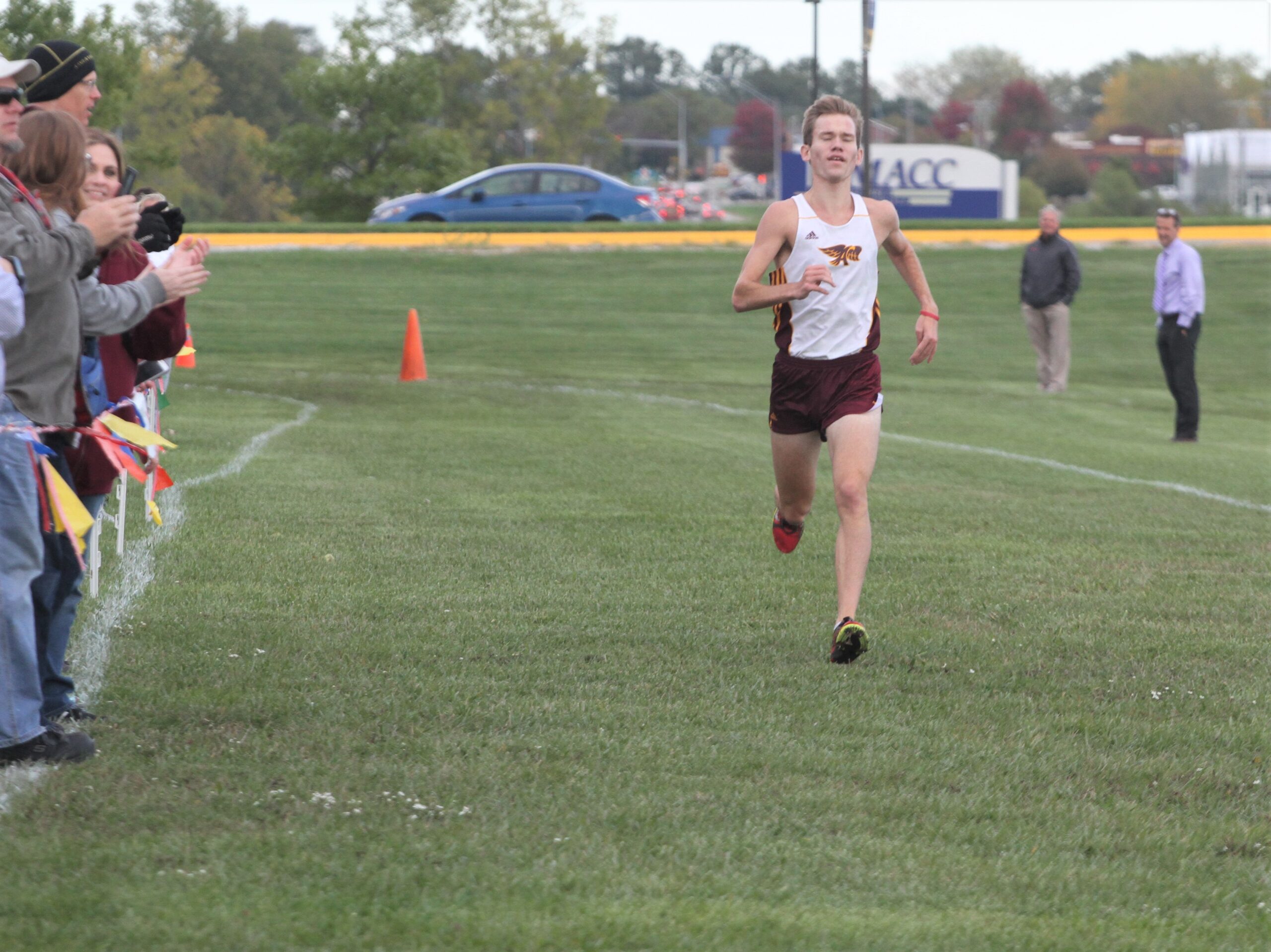
During his long tenure as the Ankeny boys’ cross country coach, Steve Arneson guided dozens of runners to an appearance in the state meet.
Ankeny qualified for state for 22 consecutive years from 1990-2011, the third-longest streak in state history. Only Cedar Falls (1992-2016) and Monticello (1997-2019) have had longer streaks.
Arneson coached the first 18 teams in that streak. Jim Robidoux guided Ankeny to state in his only season as head coach in 2008, then Chad Fickbohm took the Hawks to state three more times before the streak ended in 2012.
“I really feel blessed to have coached so many great young men,” Arneson said. “At one point we had 10 alumni competing in college, including some who never ran varsity at AHS. Several are now coaches like Jon Woehl, who is the head men’s and women’s cross country/track and field coach at Montana State. It’s fun to watch them as husbands and fathers now.”
Many of Arneson’s best runners started competing at an early age. Others, like Bryce Good and Chris Lawson, were talked into giving the sport a try.
“I played football during my whole youth up until my sophomore year in high school,” said Good, who graduated from Ankeny in 1998. “The summer prior to that school year I made the life-changing decision to switch to cross country. I had success as a freshman running varsity track the previous spring so that got the ball rolling. After talking with coach Arneson and attending the cross country preseason meeting, I made the change. I could never have imagined what would come of it.”
Lawson made a similar life-altering decision a few years later.
“I actually played football, basketball and baseball growing up. I never once thought about running as a sport,” said Lawson, who graduated in 2003. “It was Gayln Johnson, the ninth grade football coach and eighth grade track coach, and Steve Arneson who sold me on cross country over football. The summer before my freshman year, I got calls from Justin (Schlicher), Marcus (Murphy), and had conversations with TJ (Tollakson) and the Peppers brothers (Jason and Josh) who were actually neighbors of mine at the time. I gave it a go and it forever changed my life.”
Every runner that he coached was different in his own way, Arneson said. That made it a challenge to get the best out of all of his athletes.
“Each individual had their own buttons and dials that needed to be programmed for peak performance,” Arneson said. “Some of them needed pump-up talk while others needed calming down.”
The Hawks’ run of success included 11 straight top-six finishes at the state meet from 1995-2005.
“The teams I was fortunate to run for were stacked with talent,” Good said. “The advantage we all had besides having the best coaches in the state was we all pushed each other each and every day at practice. There were no easy off-days. I have no doubt because of the talent we had on the teams I was a part of was a big reason for my individual success and our team success.”
Here, then, is the Ankeny Fanatic all-time Ankeny boys’ cross country team, comprised of 21 runners on three squads:
FIRST TEAM
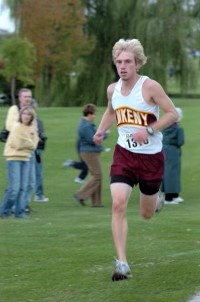
Josh Boersma. He was a four-time state qualifier at Ankeny who improved his finish at the state meet every year. “That demonstrates the high expectations he put on himself to continue to improve,” Arneson said of Boersma. As a freshman in 2003, he placed seventh in the CIML Central Conference meet and later took 69th in the inaugural Class 4A meet, helping Ankeny to a fifth-place finish. He finished fourth among all freshmen at the state meet. In 2004, Boersma placed fifth at the conference meet before finishing 41st at the state meet in 17:01, helping the Hawks to a sixth-place finish. “I attribute my success to hard work and determination,” Boersma said. “I wanted to be the best. I never became the best, but I ended up much better off than if I had never tried.” As a junior, he helped Ankeny to four titles, including a victory over defending state champ Cedar Falls at the Ames Invitational. He placed fifth at the conference meet for the second straight year and then took sixth at the district meet as the Hawks defended their crown. At the state meet, he placed 19th in a time of 16:51, leading a group of four Ankeny runners across the finish line as the Hawks earned a fourth-place finish. “Josh was part of one of the coolest state-meet finishes when top our top four guys finished 19, 20, 21 and 22 within 6 seconds of each other,” Arneson said. “As individuals each should have been in the 30s, but their teamwork lifted each of them. Those four finished in a different order all season long.” He was Ankeny’s top finisher at six different meets and led the team with a 16:58 average. In 2006, Boersma capped off his career with an outstanding senior season. He set a personal record of 15:56 to win the Ankeny Invitational, the third-fastest time in school history at the time. He won the conference race in 16:34 to lead the Hawks to a fifth consecutive league title, then raced to another victory at the district meet. He went on to earn elite all-state honors with a third-place finish in Class 4A, posting a time of 16:05. He recorded the highest finish ever by an Ankeny runner under Arneson while leading the Hawks to an eighth-place finish. He led the squad with a 16:29 average and was named the team’s Most Valuable Runner. “My favorite memory that actually beats breaking 16 minutes or finishing third at state was during my junior year, when me and my three teammates had that 6-second spread at the state meet,” Boersma said. “It was an incredible accomplishment for any team. We made each other better.”
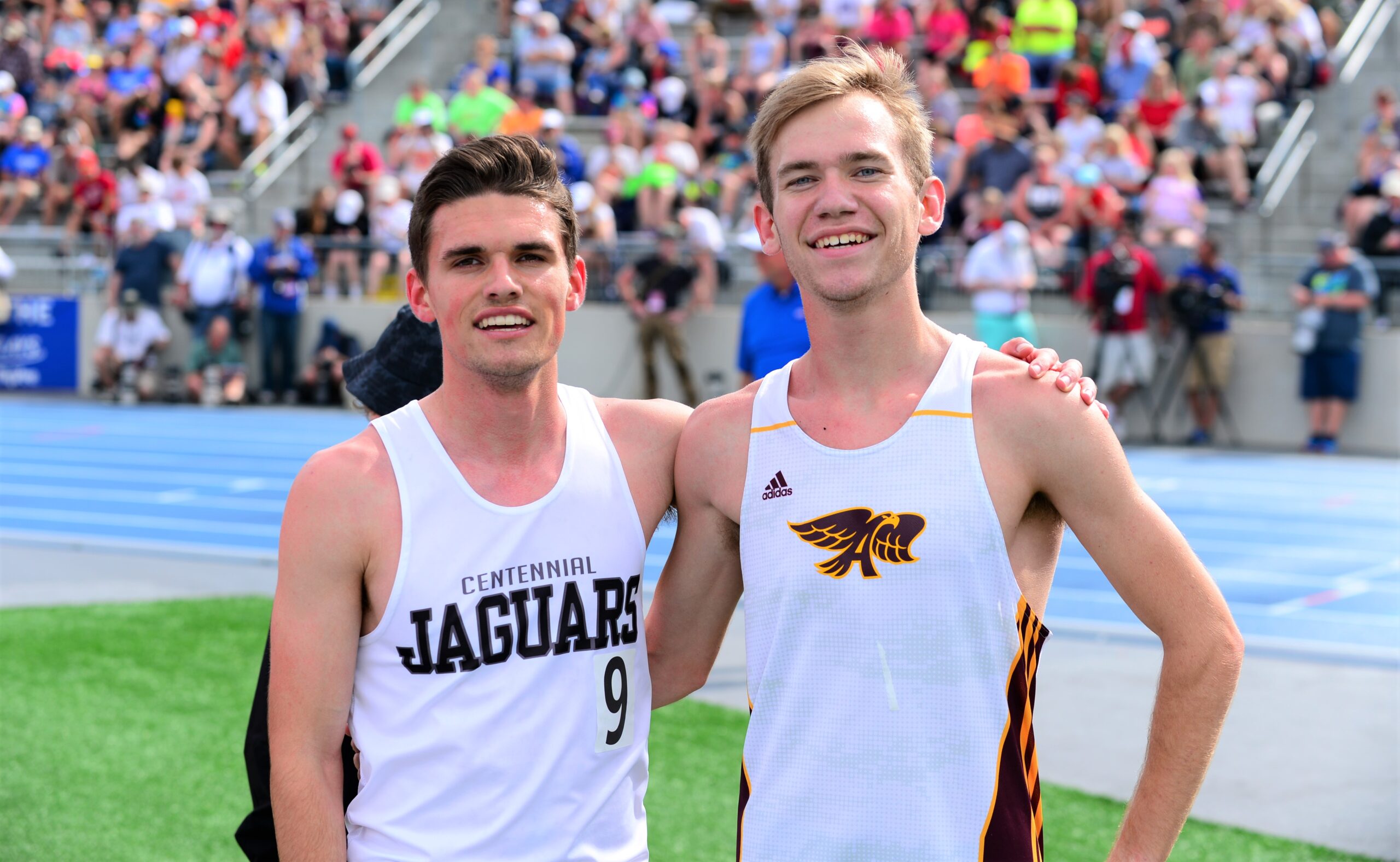
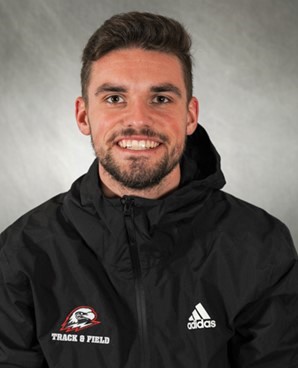
Camden Cox. He was a three-time state qualifier at Ankeny Centennial and the best runner ever produced by the Jaguars’ program under Fickbohm. In 2014, he raced to a victory at the Centennial Invitational in his first varsity race as a freshman. He later placed 11th at the district meet, just missing a trip to state. Cox won three races as a sophomore, including the Knoxville Invitational, where he led the Jaguars to the first team title in school history. He set the 5k school record and lowered it two more times, including a time of 15:58 while placing second at the Central Iowa Conference Invitational. He placed 26th at the state meet in 16:26, leading Centennial to a 13th-place finish. In 2016, Cox was the team’s top finisher at every meet. He won the Centennial and Waukee races before placing second at the Central Conference meet. He went on to place fourth at the state meet in 15:51, defeating Ankeny’s Tim Sindt in the process. Sindt went on to win the Class 4A crown in each of the next two seasons. “Tim was an outstanding competitor,” Cox said. “I find that cross country has a unique competitive atmosphere in which competitors are typically more supportive of one another than in many other sports. Tim and I had a rivalry that was definitely competitive but also supportive. When watching a race I wasn’t in or had a bad race, the only one I was ok with winning it was Tim.” As a senior, Cox placed sixth or higher at every meet and was the team’s top finisher at all nine meets. He won the Ames Invitational and had four runner-up finishes, including one at the conference meet. He led the Jaguars to the team crown at the Centennial Invitational and later set a school record of 15:21 while placing second at the Fort Dodge Invitational. He closed out his career with a third-place finish behind Sindt at the state meet, posting a time of 15:37. “It was really a special thing during the 2016-17 cross country and track seasons to see Tim and Camden battle at the top of every race they were in,” said Ankeny coach Jon Lindaman. “In my opinion, when these two athletes were both healthy they were the top two runners in the state that year by a good margin–and they were both from Ankeny. The two of them had such a mutual respect for each other and just enjoyed competing with each other. I know Tim didn’t like getting beat, but if it was Cam that beat him, he seemed ok with it.” Cox was the Jaguars’ No. 1 runner all four seasons. “My favorite memory of running cross country at Centennial would be the Pink Ribbon Run,” he said. “We would raise money to provide mammograms for women and run the game ball from the opposing high school to our stadium for the homecoming game. It was an event that unified the team for a common greater cause.” That selfless attitude is what Fickbohm will remember about Cox. “I really don’t have the words to fully express Cam as an athlete and person. He was just incredible,” Fickbohm said. “He was a humble 24-hour athlete who dedicated himself to running but didn’t let it consume him. He was very aware of his performances and how to improve throughout the season to reach his goals. He was an incredible leader for us, teaching and encouraging everyone and making sure to include all athletes in team activities.” Cox is now a distance runner on the Southern Utah men’s track team.

Bryce Good. He was a standout who led Ankeny to three straight conference titles and three consecutive fourth-place finishes at the state meet from 1995-97. According to Good, he never ran more than a couple miles at one time until the summer before his sophomore year, when he decided to join the team. “Luckily for me, I had the guidance of guys like Andy Morris, Jon Rathje and Bryan Thornburg,” he said. “They took me under their wing and to a certain degree taught me how to run distance.” As a sophomore, Good placed fifth at the conference meet before finishing 16th at state in 16:18, the fifth-best time in school history. He posted an average time of 16:54 as the Hawks went undefeated during the regular season, including a victory over eventual state champ Dubuque Senior at the Cedar Falls Invitational. “I will be forever grateful of the memories of running in high school,” Good said. “Our team trips to Spaghetti Works the nights before meets and our team hangouts up at Hawkeye Park. Also, our team huddled before going to the start line of each race listening to Van Halen’s song, ‘Right Now’.” As a junior, Good led the team with a 16:39 average. He placed second at the conference meet before finishing seventh at state in 16:00. In 1997, he won three races, placed second three times and was third three times. He raced to a victory at the conference meet in 16:03, which remains one of his favorite memories. “The meet was in Ankeny that year at Aviation Expo grounds,” Good said. “With tons of family and friends there to watch, I was able to finish in first place. I still remember to this day turning that last corner of the course and sprinting with all I had the last half mile to get to that finish line! I knew with my 800 meter sprinting ability no one was going to catch me.” Good went on to place eighth at state in a time of 15:57. He won or shared the team’s Most Valuable Runner award all three years. “Bryce was a great leader with his consistency in athleticism and character,” Arneson said. “Like most boys, he grew up playing football. His success in track led him to try cross country as a sophomore. That brave move was a story shared many times over as future runners found themselves in the same situation. The extra season of training really paid off when track season came around.” Good went on to run track at Northwest Missouri State.
Curtis LaBond. There wasn’t much information to be found on LaBond, but he was a great runner at Ankeny High School in the 1960s. He won back-to-back Class A titles in 1962-63, when the state meet was contested at a distance of 1.8 miles. He posted a time of 9:42.8 to win his first title, then defended his crown a year later with a clocking of 9:35.1. He also won the state title in the mile in 1963, posting a time of 4:46.1. As the oldest member of our squad, we’ll make him the co-captain of the all-time team.
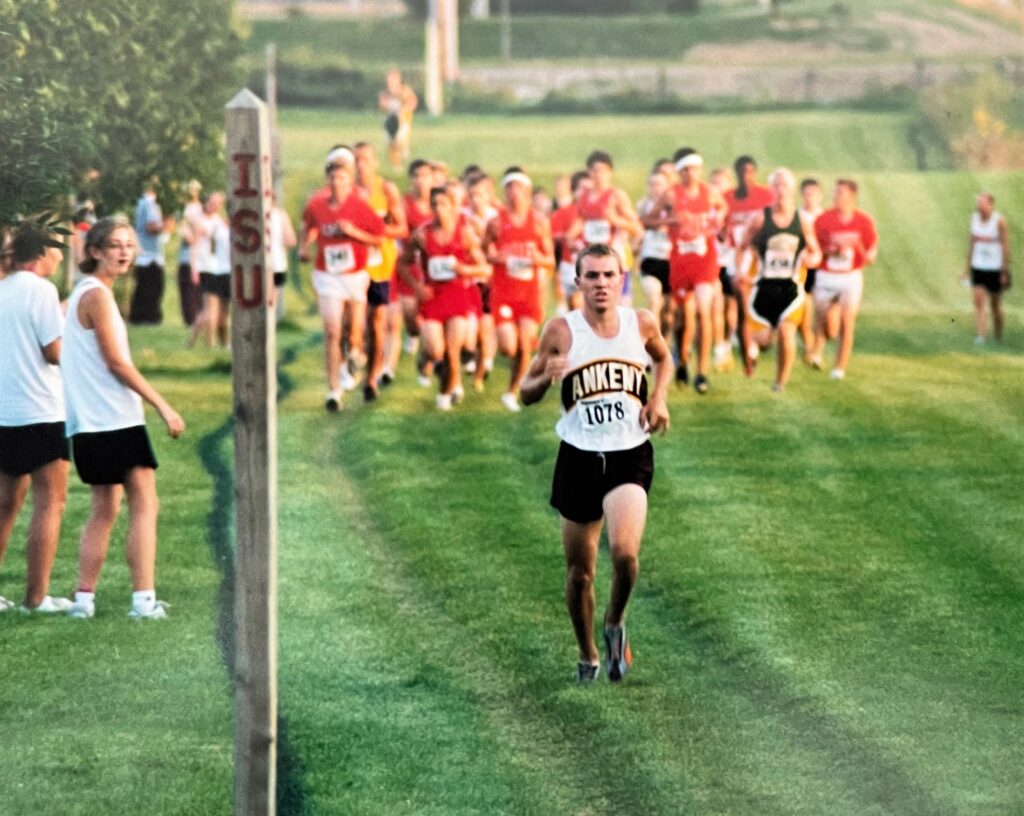
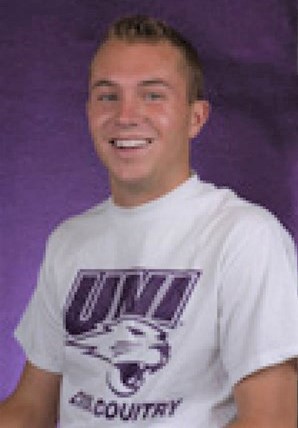
Chris Lawson. He was a four-time state qualifier who led Ankeny to back-to-back third-place finishes at the state meet in 2001-02, the school’s highest finishes in the modern era. As a freshman in 1999, he placed third on the team with a 17:26 average. He took 52nd at the state meet, helping the Hawks to a sixth-place finish. “After that race, Chris was stuck in the customary front seat by me on the ride home,” Arneson said. “I remember him telling me, ‘I’m going to be top 10 next year, Coach.’ And he did it the next three years! He was undaunted, yet friendly, in competition. He was an amazing leader and a great ambassador for our team, school and community.” In 2000, Lawson placed third or higher at seven of the nine meets and led his squad with a 16:24 average. He was the runner-up at the conference and district meets before placing sixth at the state meet in 15:53, which tied the school record. He led his unranked team to a sixth-place finish. As a junior, Lawson placed second at the Eagle Grove Invitational in 15:52, breaking his own record. He won the district meet after sitting out two races with a back injury, then placed sixth at the state meet in 15:57. He led the team with a 16:18 average, which broke another AHS mark. In 2002, Lawson placed third or higher at six different meets. He won the Ames and Newton meets and also won the conference meet, leading his team to the title. After placing second at the district meet, he raced to a fifth-place finish at the state meet in 15:46, setting a new school record. He earned all-state honors for the third time, becoming only the eighth runner in Class 3A to do so since 1990. The Hawks were ranked 10th before the state meet, but earned a second straight third-place finish, edging Iowa City High by seven points and becoming the first Ankeny team to defeat the Little Hawks. Lawson broke his own record with a 16:15 average and was named the team’s Most Valuable Runner for the third consecutive year. “There is a long tradition of great runners from Ankeny,” Lawson said. “Coach Arneson created a culture where we were able to learn and grow. I idolized all of those (previous runners) and got a chance to learn my freshman year from Justin and Marcus. I’ve been lucky to have relationships with many of these guys over the years. My quick acceleration to a state leader was really driven out of learning and motivations from the fraternity of many of these guys. Three elite all-state finishes was always a great achievement, but I would have traded them all for one team title. We had some great teams for coach Arneson, and we always wanted to win one for him. He touched the lives of so many, including myself.” Lawson went on to run at Northern Iowa, where he became an all-Missouri Valley Conference runner and was a part of nine MVC titles in cross country and track.

Lee Schreurs. He was a star on the 1969 Ankeny team who led the Hawks to the Class AA state title, placing second in the 2-mile race. He also won the individual state championship in the mile, posting a time of 4:35.1 while leading Ankeny to a runner-up finish. “This is an unexpected honor for me and my teammates who were working hard to win a state championship,” said Schreurs, who also set the 2-mile school record of 10:03. “I still have my championship medal.” The Hawks finished with 19 points at the 2-mile state meet under coach Bill Ormston, getting a sixth-place finish from Mark Trusty. “My memories are that we all enjoyed being around each other pushing and cheering on all teammates to do their best,” Schreurs said. “We had a great coach in Bill, who made our workouts hard but fun.” Dan Marquardt, Ron Lennard and Kim Olofson rounded out Ankeny’s lineup. “It was definitely a memorable couple of years for us. I’m very proud to know we were state champions,” said Lennard, who also ran on the state championship mile team in 1970. “Even with all the great runners and great teams Ankeny has seen over the years, I am still very humbled to know that these are Ankeny’s only state cross country championships. Sadly, my very best high school friend, Mark Trusty, passed away a few years ago. But we are forever grateful to our coach, Mr. Ormston, for guiding us. I talk with him a few times a year still. He lives in Marshalltown.” Schreurs has continued to follow Ankeny’s cross country teams over the years, even becoming good friends with Good along the way. “Our families are close,” Good said. “So much so that I’ve always referred to him as Uncle Lee.”
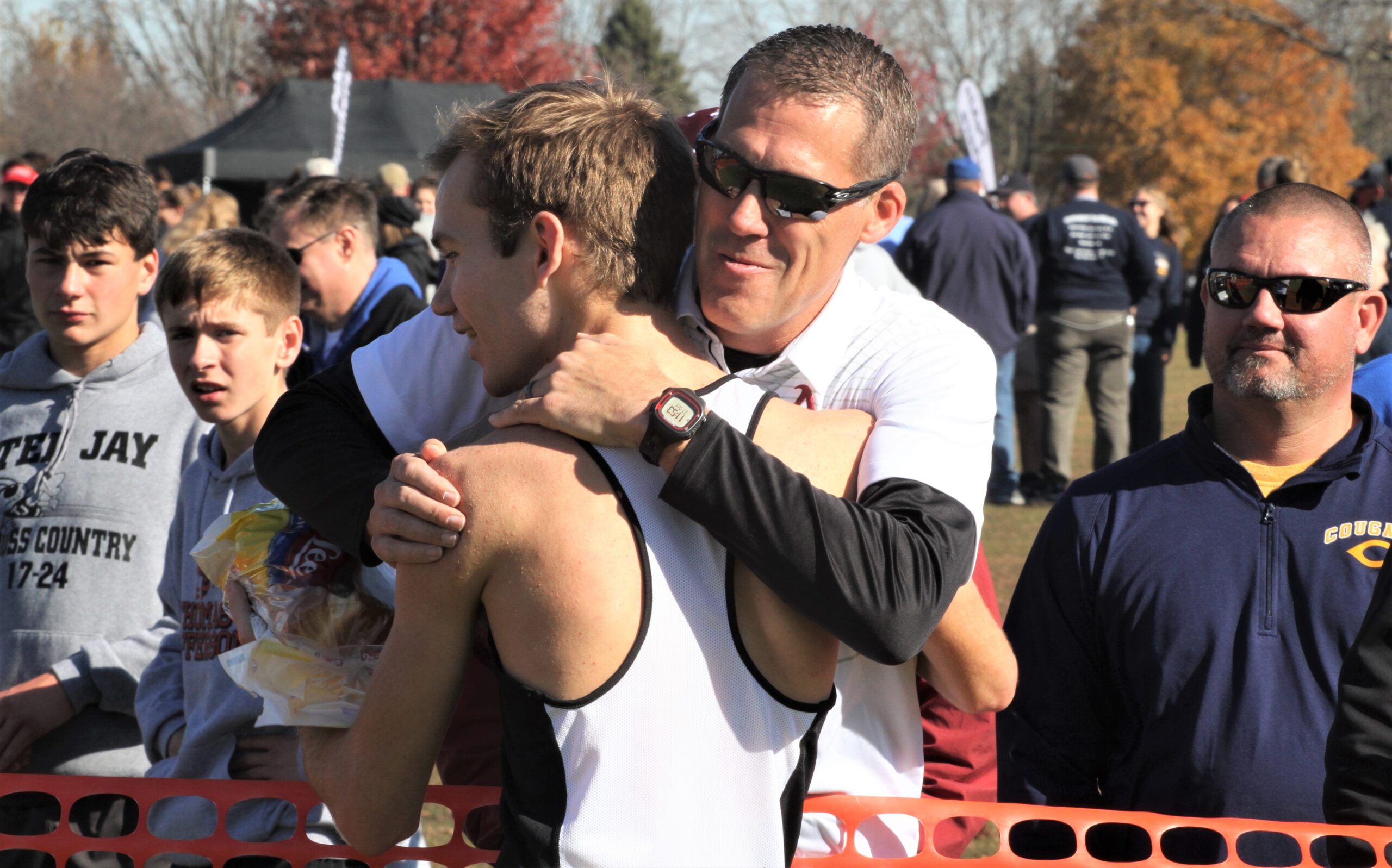
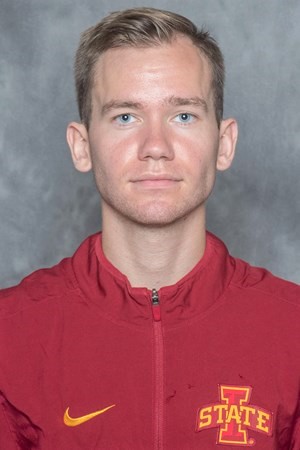
Tim Sindt. He was a four-time state qualifier who capped off his Ankeny career with back-to-back titles in 2017-18, joining LaBond as a two-time champion. His rise to stardom, though, came as somewhat of a surprise to Arneson. “I didn’t coach him in high school, but it’s worth noting that he was never the No. 1 runner on his eighth grade team. It was similar to my experience coaching Lauren McMahon in eighth grade,” Arneson said of the current Ankeny girls’ standout. “You just never know the successes one may have if they just stick with it.” As a freshman in 2015, Sindt qualified for the state meet as an individual and placed 36th in a time of 16:32. He then won two races as a sophomore, including the Southeast Polk Invitational, where he led the Hawks to the team title. He later led Ankeny to its first state-meet appearance under Lindaman, placing eighth in 16:01 as the Hawks earned a 13th-place finish. In 2017, he won seven of his nine races, including the last five. He set the school record of 15:14 at the Fort Dodge Invitational and again led Ankeny to the Southeast Polk title. At the state meet, Sindt raced to the victory in 15:24 to lead the Hawks to a 12th-place finish. “I was able to congratulate Tim both when he broke my 5k record and also once he won state,” Lawson said. “He was able to do what I wasn’t able to do in winning the state title. I was so happy for a Hawk to bring that title to Ankeny.” As a senior, Sindt completed his career with an undefeated season, winning all eight of his races after overcoming a scary heart diagnosis. He won the prestigious Rim Rock Classic race in Kansas in 15:11, which remains his favorite high school memory. “It was a fun trip with the team, and the competition there was very strong with runners from several different states,” he said. Less than two weeks later, Sindt won the Centennial Invitational at DMACC in a time of 14:51, which set an all-time state record while leading his team to the crown. “I can remember sitting down and talking with him at the start of his senior year,” Lindaman said. “He looked at our schedule, pointed to the Fort Dodge meet and said, ‘This is the meet I am going to run sub-15 minutes.’ Unfortunately, the meet was moved to DMACC, but of course he still went out and ran (14:51) that week. This was the most impressive race a high school kid has ever run in the state of Iowa.” After defending his conference title, Sindt went on to win his second straight Class 4A crown in 15:36, becoming the first repeat large-school champ in more than a decade. “Each state title had its own unique challenges that made them difficult, but I think my second title was more difficult,” Sindt said. “My junior year I was really trying to prove to people that I belonged with the best in the state and I wasn’t the best runner at the start of that season but I had to put my head down and keep working hard the rest of the way to end up winning only by about a second. My senior year I felt most of the season that I was going to win again, but about four weeks from state my hip started hurting me and got progressively worse as I kept running. I had to practically beg coach Lindaman to let me keep training. By the time state came around I was only running three to four days a week because I was hurting so bad. Looking back at that race I feel like there were a couple of guys who could’ve beaten me given the shape I was in, but somehow I managed to make it through the race to win again.” Sindt led Ankeny to a fifth-place finish, its best performance under Lindaman and the Hawks’ highest finish since 2005. “Tim obviously has loads of natural talent and puts in a ton of effort, but his greatest strength is his mental toughness,” said Ankeny assistant coach Justin Schlicher. “I’ll never forget his ability to develop racing strategies and how he had the focus throughout his races to do what he had to do to be successful.” Sindt is now a sophomore on the Iowa State men’s track and cross country teams. “Like many athletes I have coached, Tim was a hard worker. He put in the time and was dedicated to be the best possible version of himself he could be,” Lindaman said. “What set Tim aside from all other athletes I have coached was his determination and mental preparation. He was blessed with a great deal of running talent, but his ability to accomplish his goals–whether it be times or places–was simply remarkable. As he prepared throughout the week, if he said he was going to accomplish something, he would do exactly what he set out to do–literally EVERY time. He was the most coachable kid I have ever worked with and bought in to our program 100 percent. He never once questioned what we were doing and always understood that each day, meet and season was another step in his journey. His mental toughness also allowed him to embrace challenges, obstacles and setbacks in his career. Like all other athletes in 2018, he had to deal with extreme weather throughout his senior season. He was still running unbelievably fast times in 100-degree heat and on rainy, sloppy courses. What many people don’t know is all that this young man had to overcome in his high school running career in terms of injury. He battled back from a major heart condition and won his second state title on an extremely serious and painful hip injury.” Let’s make Sindt the co-captain of our squad along with LaBond.
SECOND TEAM
Chris Charles. He teamed up with the next runner on this list, Johnny Fuller, to give Ankeny’s 1990 team a dynamic duo that few squads in the state could match. Ankeny won four titles that season, including the conference meet, where the Hawks finished 13 points ahead of Indianola to end the Indians’ three-year reign as champions. He placed second behind Fuller at five consecutive meets before placing fourth at the state meet in a time of 16:39 to lead Ankeny to a fifth-place finish. “Those two were the streak starters,” Arneson said. “They both finished in the top 10 at a cold, snowy state meet. They both had exceptional closing speed.” After Fuller graduated, Charles became the Hawks’ No. 1 runner as a senior in 1991, when he won the Marshalltown Invitational and had six other top-five finishes. He set a personal record of 16:17 at the National Division meet before placing 22nd at the state meet, where he posted a time of 17:08 while leading Ankeny to an 11th-place finish. For the second straight year, he placed third or higher in seven of his 10 races. He posted an average time of 17:01 and was named the team’s Most Valuable Runner.
Johnny Fuller. As a junior in 1989, he placed ninth at the Valley Invitational in 16:40, the second-fastest 5k time in school history at that point. He later took fifth at the district meet to qualify for state. “Johnny was the last individual qualifier we had before the team streak started,” Arneson said. He went on to place 35th in a time of 17:04. “I didn’t know what to expect,” Fuller said at the time. “It was harder running by myself instead of running with the whole team.” As a senior, he won seven races, including the conference and district meets. He twice set a new 5k record, posting a time of 16:13 at the Marshalltown Invitational and then running 16:09 a week later at the Valley Invitational. In his final race, he placed eighth at the state meet in 16:48, finishing four spots behind Charles. “We came home without any idea of our team place. Then we saw on the news that we finished fifth,” Arneson said. “Both Johnny and Chris had natural abilities that really challenged me to maximize workout planning early in my coaching career.” Fuller was named the team’s Most Valuable Runner for the second year in a row.
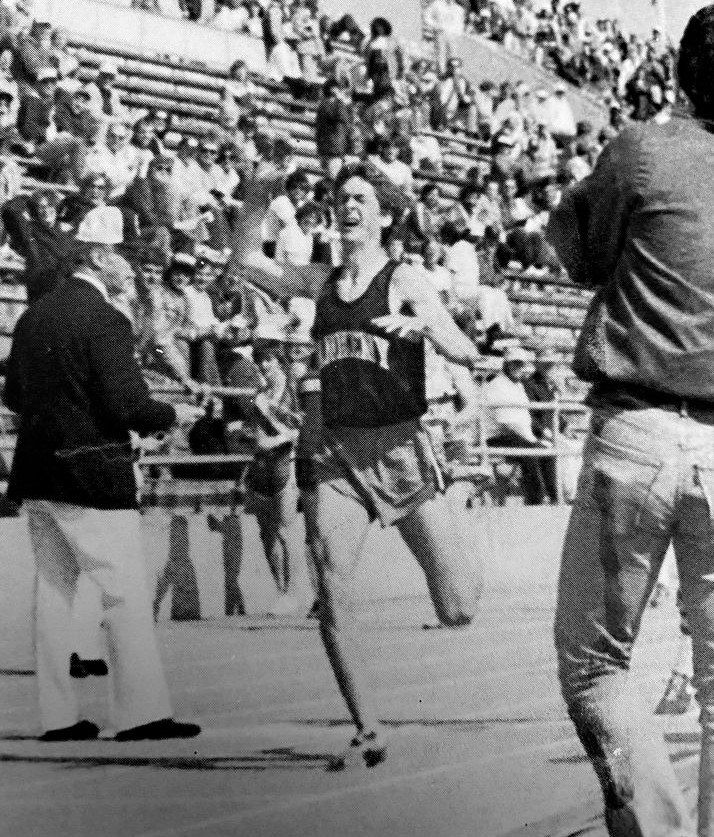
Chris Leonard. He was a two-time state qualifier at Ankeny in the 1970s under coach Scott Osborn, who just passed away last weekend after a long battle against ALS. As a junior in 1978, Leonard won the Central Iowa Conference title and then placed second at the district meet to qualify for state as an individual. He went on to place 26th in a time of 10:30. As a senior, he set a school record of 9:26, breaking his own mark by 31 seconds. He completed his career with a sixth-place finish at the state meet. He posted an average time of 10:05, setting a school record at the time. “Coach Osborn was always there and always prepared; he wasn’t bored with repetitive process,” Leonard said. “He laid things out in a cause-and-effect fashion, then he kind of left it up to you. He and coach Pattee (for track) were pretty amazing with meet prep and accurate split sheets for everyone the next day and their ability to meet you where you were. Growing up and getting a solid education in Ankeny in the late 70s was also amazing. There was community support that promoted independence and internal motivation which is certainly necessary in distance running.” Leonard was part of a running family. He followed in the footsteps of his brother Andy, who set the school record of 10:01 in 1977–a mark that was later eclipsed by Chris. His younger brother, Tim, ran on Ankeny’s 1982 team that placed 14th at the state meet. “The Leonards were a single-parent family and Coach O and P really helped me find something I was good at,” Leonard said. “I probably worked too hard; I can see now. I still do the jolly jog thing, but I am much more appreciative of the process. And very appreciative of Ankeny as a community and Coach Oz in particular. I’m sure the same goes for many of us–certainly Andy and Tim, too.”
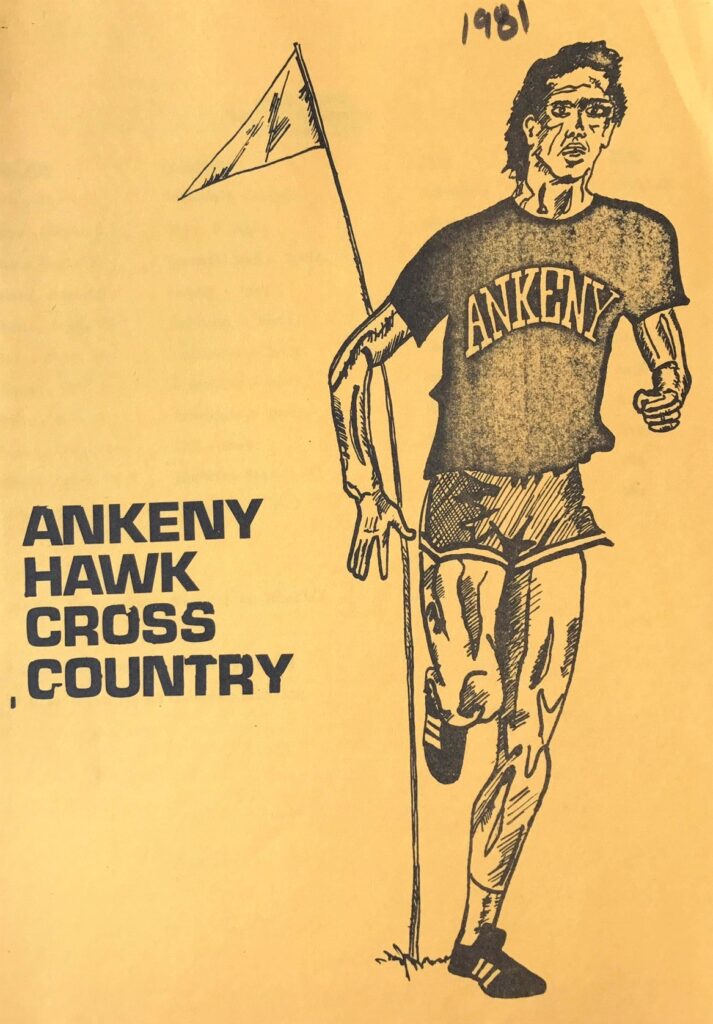

Dan Marquardt. He was a key part of Ankeny’s state championship 2-mile team in 1969, placing 11th for the Hawks. He then became Ankeny’s No. 1 runner in 1970, when he won the Class AA mile state title in a time of 4:42.8 and led the Hawks to the team crown under coach Bill Rauhauser. “I was extremely proud of the boys this year–they did very outstanding overall,” Rauhauser said at the time. “Finishing first in the mile and third in the 2-mile speaks for itself.” Trusty placed fourth and Lennard finished seventh for the Hawks. “The first half of the season was a mile team race on a regular running track. It got kind of crowded at times!” Lennard said. “We participated in a number of meets, then had a state championship. We ran at Ames High School that year. Then the season switched to a 2-mile competition, usually on the golf course. Dan was definitely our leader all year in 1970. We had a very successful season, but I can’t understand why the (Iowa High School Athletic Association) doesn’t acknowledge our mile state team championship that we won. But we will always know we were state champions! I will certainly always know and remember we won it all!”
Andy Morris. Like Boersma, he was a four-time state qualifier who improved his finish at the state meet every year. In 1991, he placed 105th while helping the Hawks to an 11th-place finish. He also ran the fastest race ever by an Ankeny freshman. In 1992, he duplicated that feat by running the fastest race ever by a sophomore. He placed second on the team with a 17:30 average and took 65th at the state meet, helping Ankeny to a 12th-place finish. As a junior, he placed fifth at the Newton Invitational to lead the Hawks to the team title. He later took 22nd at the state meet in 16:32, leading Ankeny to a 10th-place finish. He had nine top-10 finishes and ran the fastest race ever by an Ankeny junior. He was named the Hawks’ Most Valuable Runner after leading the team with a 17:23 average. In 1994, he won the Valley Invitational for his first cross country victory. He posted an average time of 16:47 as Ankeny won eight titles before placing second at both the conference and district meets. He then placed 10th at the state meet in 16:06, the second-fastest time in school history. He was named the team’s Most Valuable Runner along with Jason Peppers. “His maturity was beyond his age,” Arneson said. “He really groomed the younger guys on the team to step up. His influence continued after he graduated and went on to run steeplechase at Iowa. (It’s) no surprise he continued on to coach cross country himself.”
Ryne Murphy. He ran for three different coaches from 2007-10, but improved dramatically along the way. As a freshman in Arneson’s final season, Murphy didn’t even crack the varsity lineup. However, he was named the Most Improved Runner on the 9/10 squad. “I was only with him for one year, but I could see the potential early on,” Arneson said. In 2008, he placed fourth on the team with a 17:41 average. He finished 55th at the state meet in a time of 16:29, helping the Hawks to a 10th-place finish in Robidoux’s only season as head coach. “He was a complete surprise who came into the program as an unheralded youngster with zero fanfare,” Robidoux said of Murphy. “Ryne always performed exactly to the race plan with zero deviation. He was 100 percent reliable. He may have been one of the quietest lions ever, because once he started running he just kept gobbling up the competition. You could tell him we need two points, and he would look you straight in the eye, and he would get two points plus one more!” As a junior, Murphy was Ankeny’s top finisher at seven of the eight meets and had seven top-10 finishes. He won the Ames Invitational, leading the Hawks to the team title. He later won the conference and district meets before placing sixth at state in a time of 16:01, helping the Hawks to an 11th-place finish in Fickbohm’s first season. He led the team with a 16:35 average. In 2010, Murphy set a personal record of 15:53 while placing fifth at the Fort Dodge Invitational–one of his six top-10 finishes. He placed fifth at the conference meet and fourth at the district meet before finishing 35th at the state meet, where he tripped and fell and suffered a sprained ankle early in the race but recovered and still managed to cross the finish line in 16:26. He helped Ankeny to a 15th-place finish and was named the team’s Most Valuable Runner for the second straight year. “Ryne was one tough competitor,” Fickbohm said. “He is the example of pushing yourself harder than you thought possible and not giving in–and good things happen. The way he raced the 2009 state meet was incredible. He put himself in a position early that pushed his limits and competed the entire race to finish sixth.”
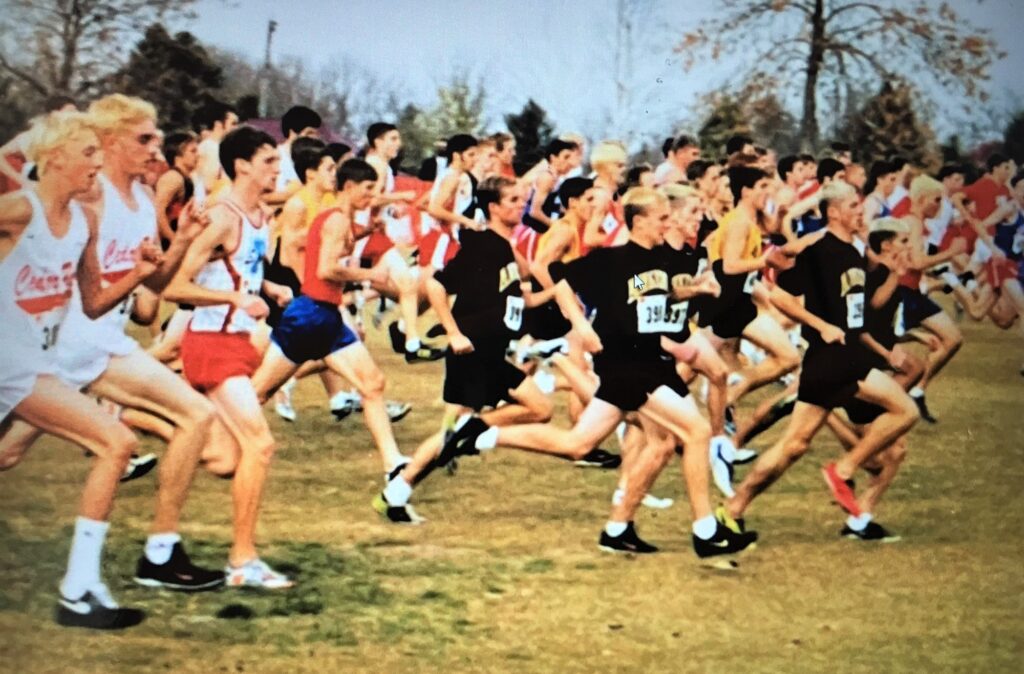
Justin Schlicher. He was a four-time state qualifier from 1996-99 who twice placed in the top 15 and never finished lower than 31st, which is where he placed as a freshman. Schlicher said he developed a love for running during PE class. “For some reason, I always loved how we were forced to run the mile and I actually loved seeing how many people I could lap. It was a game to me.” He helped the Hawks to four titles in 1996. He won the freshman race at the Ankeny Invitational and later posted a time of 16:34 to help Ankeny to a fourth-place finish at the state meet. As a sophomore, Schlicher was the runner-up at the conference meet as the Hawks won the league crown for a third straight time. The team captured seven other titles, including the district crown, before placing fourth at the state meet–where Schlicher took ninth in a time of 15:58. In 1998, he won the Newton Invitational and later set a school record of 15:56 while winning the junior race at the Ankeny Invitational, his third consecutive Ankeny victory. He took second at the district meet and then finished 14th in 16:02 at the state meet, where he led the Hawks to a sixth-place finish. He led the team with a 16:20 average, which set a school record, and was named the squad’s Most Valuable Runner. In 1999, he placed in the top 10 at seven different meets. He held the lead in the first mile at the state meet before finishing 22nd in 16:04, leading Ankeny to another sixth-place finish. He placed second on the team with a 16:41 average. Schlicher said his favorite memory from running cross country was the rides on a Suburban to the varsity meets. “Those were great ways to build camaraderie through banter and storytelling,” he said. Schlicher is now an assistant coach for the Ankeny squad. “As a part of the current staff, Justin probably has the best awareness of the tradition,” Arneson said. “He was extremely efficient as a runner. His smooth gait could be spotted from far away. Like the middle man on a relay team, he learned from Bryce Good and passed the baton to Chris Lawson. He and Marcus Murphy were a solid 1-2 punch we could always count on during their years.”
THIRD TEAM
Blair Boehm. He was a four-time state qualifier who earned a pair of top-25 finishes while playing a key role on some of Arneson’s best teams from 2001-04. As a freshman, he placed 41st at the state meet in 16:40. He was the team’s No. 5 runner with an average time of 17:19. In 2002, he placed third at the conference meet, helping Ankeny to the team title. He later took 25th at the state meet in 16:19, helping the Hawks to a second consecutive third-place finish. He placed second on the team with a 16:57 average. As a junior, Boehm again placed third at the conference meet to lead Ankeny to another league crown. He later took 42nd at the state meet in 16:33, helping the Hawks to a fifth-place finish. He led the team with a 16:59 average. In 2004, Boehm was the individual conference champion in a time of 16:56, earning all-league honors for the third straight year as Ankeny claimed a third consecutive crown. He placed second at the district meet before finishing his career with a 21st-place finish at the state meet, where he posted a time of 16:46 to help the Hawks to a sixth-place finish. He was the team’s top finisher at seven different meets and had five top-10 finishes. He led the team with a 16:46 average and was named the squad’s Most Valuable Runner for the second year in a row. “Like Schlicher, Blair was very cerebral. He liked to know why we were doing various workouts,” Arneson said. “He was also an ultimate frisbee star. Game days were a fun part of our routines.”
Tim Huegerich. He was another four-time state qualifier who was a teammate of Boehm’s for three seasons from 2001-03. As a freshman in 2000, he placed 55th at the state meet, helping Ankeny to a sixth-place finish. In 2001, he placed fourth on the team with a 17:13 average. He took 45th at the state meet in a time of 16:44, helping the Hawks to a third-place finish. As a junior, Huegerich helped Ankeny to another third-place finish at the state meet, where he took 12th in 16:04. He was the highest finishing unranked runner in the field. “Tim was just the opposite (of Boehm),” Arneson said. “He was a big natural athlete; he would just line up and go. His 12th-place finish at state was a good example of that. He ran practices with Chris Lawson every day so he just followed Chris in that race and finished seven spots behind him. The team during those years was an intimidating looking crew–in addition to Tim there was Todd Vogel and Travis Olsen.” In 2003, Huegerich helped Ankeny to five titles. He placed fourth at the conference meet as the Hawks defended their league title. He later ended his career with a 26th-place finish at the state meet, posting a time of 16:17 while helping Ankeny to a fifth-place finish.
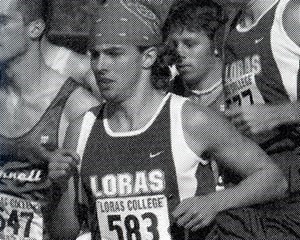
Marcus Murphy. He was a three-time state qualifier who went on to become a Hall of Famer at Loras College. As a sophomore in 1997, Murphy placed 42nd at the state meet in 16:17, helping Ankeny to a fourth-place finish. In 1998, he took 10th at the Cedar Falls Invitational as the Hawks defeated eventual state champion Dubuque Senior. He placed sixth at the conference meet and later took 37th at the state meet in 16:27, helping Ankeny to a sixth-place finish. He was second on the team with a 16:50 average. As a senior, Murphy placed seventh or higher at eight different meets. He set a school record of 15:53 while placing third at the Eagle Grove Invitational. He later took 24th at the state meet in 16:05, helping the Hawks to another sixth-place finish. He led the team with a 16:20 average, which tied Schlicher’s record from the year before, and was named the squad’s Most Valuable Runner. “A student of running, Marcus was small in stature but was huge in curiosity about how to improve,” Arneson said. “His time at Ankeny was just a peek at the college success he’d have. He was another natural leader who took his turn being a role model for teammates.” Murphy went on to win four Iowa Conference championships in cross country at Loras, earning conference MVP honors each of his four seasons as a Duhawk. He added three all-conference honors in track and field as well as five all-American distinctions–three in cross country and two in the 5k for track and field. He was inducted into the Loras Athletics Hall of Fame in 2018.
Jason Peppers. He was a three-time state qualifier who made a sensational debut as a freshman in 1994, when he won the Ames Invitational in 16:23 in his first varsity race. “He tore to the front right away,” Arneson said. “His senior teammate, Andy Morris, was part of the chase pack. Andy tells how the others were laughing about Jason’s foolish start. But he calmly told them, ‘Jason’s legit.'” He placed third at the conference meet in 15:59, setting a school record. He then injured his knee after falling at the start of the district meet, but recovered enough in the next week to place 46th at the state meet in 16:44, helping Ankeny to a seventh-place finish. “He sliced his leg pretty good and got stitches and didn’t move his leg for the next week,” Arneson said. “He was on crutches two days before the state meet, but he decided the last minute to try running. That leg finally loosened up during the race, and he ran negative splits to move from the 90s up to 46th.” Peppers had five top-three finishes and led the team with a 16:29 average, the fastest in school history. He was named the squad’s Most Valuable Runner along with Morris. As a sophomore, he led the team with a 16:44 average and was again named the squad’s Most Valuable Runner–this time along with Good. He won the Indianola Invitational and later placed third at the conference meet, leading the Hawks to the title. He placed 27th at the state meet in 16:30 as Ankeny earned a fourth-place finish. In 1996, Peppers got off to a slow start and eventually left the team after struggling to find his form. He then returned to the squad as a senior, when he won the Indianola Invitational and had four second-place finishes. He took fourth at the conference meet as the Hawks captured their third straight crown. He later placed 33rd at the state meet in 16:10, helping Ankeny to a fourth-place finish. “His great success as a youngster led to a letdown by his junior year when racing just wasn’t fun,” Arneson said of Peppers’ departure from the team. “But I’m glad he came back out as a senior.”
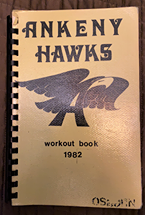
Mike Schmitz. He was a two-time state qualifier at Ankeny in the 1980s. As a junior in 1981, he helped the Hawks to the Central Iowa Conference title. He went on to place 20th at the state meet in a time of 10:08 as Ankeny earned a fifth-place finish. In 1982, the Hawks won five of seven invitationals and captured their third straight league crown. Schmitz led the way despite battling an injury for much of the season. He recorded a personal best time of 9:55 and posted a 10:21 average. In his final race at the state meet, he placed 34th in a time of 10:20 to lead Ankeny to a 14th-place finish. His brother, John, was also a standout at Ankeny–placing 29th at the state meet in Arneson’s first season in 1987, when the event was switched to the 5k distance. While doing research for this story, I got ahold of Mike–my former classmate–through Facebook. He modestly did not want to be named to the all-time team. “Nah, I should not be included,” he wrote. “(There were) many, many better runners. But the 1981 team, as a whole, was one of the best.” I will respectfully disagree with Schmitz. He belongs on this list.

T.J. Tollakson. He was never the No. 1 runner on any of his Ankeny teams from 1995-98, but he was a valuable and consistent point scorer who went on to become a professional triathlete. As a freshman, he placed 28th at the state meet in 16:30, helping the Hawks to a fourth-place finish. In 1996, he won the sophomore race at the Ankeny Invitational and later placed fourth at the conference meet as Ankeny won the league title. He finished 22nd at the state meet in 16:29 as the Hawks again placed fourth. As a junior, Tollakson took 77th at the state meet, helping Ankeny to another fourth-place finish. In 1998, he was the team’s No. 3 runner with a 17:02 average. He placed 58th at the state meet in his final race, helping the Hawks to a sixth-place finish. “He was the ultimate competitor,” Arneson said. “Like a lot of successful cross country runners, T.J. came from a soccer background so his aerobic capacity was well established. He showed great character as he continued to lead even as younger teammates would finish ahead of him. (It’s) no surprise to see him excel in his triathlon passion.”
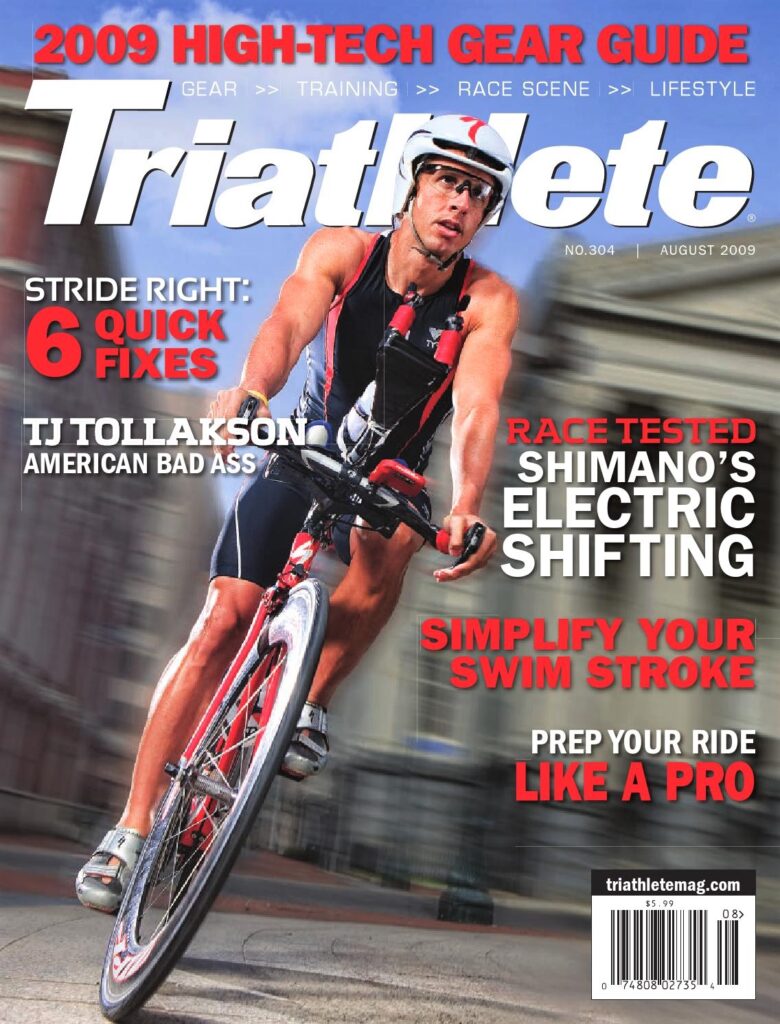

Jack Vandenberg. He was one of the runners that Schmitz felt should be on the list, and he’s right. Vandenberg placed third at the conference meet as a junior in 1980, leading the Hawks to their first league title in six years. He was the runner-up at the Indianola Invitational. As a senior, he helped Ankeny to four titles, including its first-ever district crown. He also raced to a victory at the conference meet as the Hawks defended their title. At the state meet, he placed 12th in 10:03, the third-fastest time in school history at the time. He led his team to a fifth-place finish. “One of my favorite memories is coach Osborn saying if we won the meet he would let us listen to music on the bus ride home,” Vandenberg said. “Coach introduced us to Roy Orbison’s version of ‘Oh, Pretty Woman’ and not the Van Halen version.”
(EDITOR’S NOTE: The Ankeny Fanatic teams were selected by publisher Dan Holm, who consulted with former and current coaches before making his picks.)
